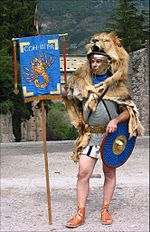
The Roman legion, the largest military unit of the Roman army, comprised 4,200 infantry and 300 equites (cavalry) in the period of the Roman Republic and 5,600 infantry and 200 auxilia in the period of the Roman Empire.
The spatha was a type of straight and long sword, measuring between 0.5 and 1 m, with a handle length of between 18 and 20 cm, in use in the territory of the Roman Empire during the 1st to 6th centuries AD. Later swords, from the 7th to 10th centuries, like the Viking swords, are recognizable derivatives and sometimes subsumed under the term spatha.
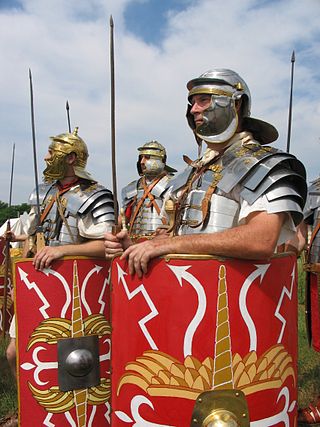
The Roman legionary was a professional heavy infantryman of the Roman army. These soldiers would conquer and defend the territories of ancient Rome during the late Republic and Principate eras, alongside auxiliary and cavalry detachments. At its height, Roman legionaries were viewed as the foremost fighting force in the Roman world, with commentators such as Vegetius praising their fighting effectiveness centuries after the classical Roman legionary disappeared.

A peltast was a type of light infantry originating in Thrace and Paeonia and named after the kind of shield he carried. Thucydides mentions the Thracian peltasts, while Xenophon in the Anabasis distinguishes the Thracian and Greek peltast troops.

The scutum was a type of shield used among Italic peoples in antiquity, most notably by the army of ancient Rome starting about the fourth century BC.
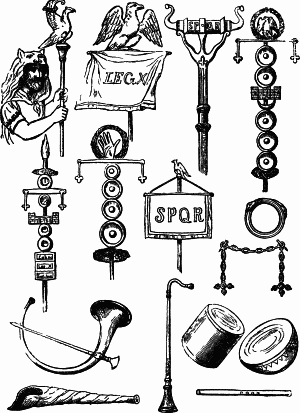
Roman military personal equipment was produced in large numbers to established patterns, and used in an established manner. These standard patterns and uses were called the res militaris or disciplina. Its regular practice during the Roman Republic and Roman Empire led to military excellence and victory. The equipment gave the Romans a very distinct advantage over their barbarian enemies, especially so in the case of armour. This does not mean that every Roman soldier had better equipment than the richer men among his opponents. Roman equipment was not of a better quality than that used by the majority of Rome's adversaries. Other historians and writers have stated that the Roman army's need for large quantities of "mass produced" equipment after the so-called "Marian Reforms" and subsequent civil wars led to a decline in the quality of Roman equipment compared to the earlier Republican era:
The production of these kinds of helmets of Italic tradition decreased in quality because of the demands of equipping huge armies, especially during civil wars...The bad quality of these helmets is recorded by the sources describing how sometimes they were covered by wicker protections, like those of Pompeius' soldiers during the siege of Dyrrachium in 48 BC, which were seriously damaged by the missiles of Caesar's slingers and archers.
It would appear that armour quality suffered at times when mass production methods were being used to meet the increased demand which was very high the reduced size cuirasses would also have been quicker and cheaper to produce, which may have been a deciding factor at times of financial crisis, or where large bodies of men were required to be mobilized at short notice, possibly reflected in the poor-quality, mass produced iron helmets of Imperial Italic type C, as found, for example, in the River Po at Cremona, associated with the Civil Wars of AD 69 AD; Russell Robinson, 1975, 67
Up until then, the quality of helmets had been fairly consistent and the bowls well decorated and finished. However, after the Marian Reforms, with their resultant influx of the poorest citizens into the army, there must inevitably have been a massive demand for cheaper equipment, a situation which can only have been exacerbated by the Civil Wars...
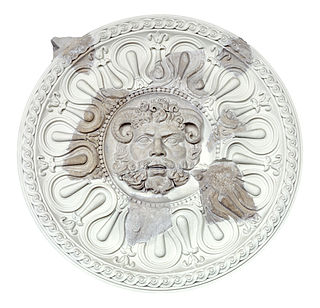
In the military of classical antiquity, a clipeus was a large shield worn by the Greek hoplites and Romans as a piece of defensive armor, which they carried upon the arm, to protect them from the blows of their enemies. It was round in shape and in the middle was a bolt of iron, or of some other metal, with a sharp point. The clipeus was more-or-less identical to the earlier aspis.

A javelin is a light spear designed primarily to be thrown, historically as a ranged weapon. Today, the javelin is predominantly used for sporting purposes such as the Javelin throw. The javelin is nearly always thrown by hand, unlike the sling, bow, and crossbow, which launch projectiles with the aid of a hand-held mechanism. However, devices do exist to assist the javelin thrower in achieving greater distances, such as spear-throwers or the amentum.

The Montefortino helmet was a type of Celtic, and later Roman, military helmet used from around 300 BC through the 1st century AD with continuing modifications. This helmet type is named after the region of Montefortino in Italy, where a Montefortino helmet was first uncovered in a Celtic burial. The Montefortino helmet originated in the 4th century BCE and was influenced by Etruscan and Celtic helmets. The helmet was brought to Italy by the Senones and it was the most popular helmet amongst the Roman army during the Republican period. The Montefortino helmet remained the most popular Roman helmet until the first century CE. Although in the Roman military it was replaced by the Coolus helmet, it continued to be used by the Praetorian guard.

In Ancient Greek armies, the psiloi were the light infantry who usually acted as skirmishers and missile troops, and who were distinguished from the armored hoplitai by their light weapons and lack of armor.

Velites were a class of infantry in the Roman army of the mid-Republic from 211 to 107 BC. Velites were light infantry and skirmishers armed with javelins, each with a 75cm wooden shaft the diameter of a finger, with a 25cm narrow metal point, to fling at the enemy. They also carried short thrusting swords, or gladii, for use in melee. They rarely wore armour as they were the youngest and poorest soldiers in the legion and could not afford much equipment. They did carry small wooden shields called parma for protection, and wore headdresses made from wolf skins so their brave deeds could be recognized. The velites were placed at the front partly for tactical reasons, and also so that they had the opportunity to secure glory for themselves in single combat.
Hastati were a class of infantry employed in the armies of the early Roman Republic, who originally fought as spearmen and later as swordsmen. These soldiers were the staple unit after Rome threw off Etruscan rule. They were originally some of the poorest men in the legion, and could afford only modest equipment—light chainmail and other miscellaneous equipment. The Senate supplied their soldiers with only a short stabbing sword, the gladius, and their distinctive squared shield, the scutum. The hastatus was typically equipped with these, and one or two soft iron tipped throwing spears called pila. This doubled their effectiveness, not only as a strong leading edge to their maniple, but also as a stand-alone missile troop. Later, the hastati contained the younger men rather than just the poorer, though most men of their age were relatively poor. Their usual position was the first battle line. They fought in a quincunx formation, supported by lighter infantry. The enemy was allowed to penetrate the first battle line consisting of hastati, after which the enemy would deal with the more hardened, seasoned soldiers, the principes. They were eventually disbanded after the so-called "Marian reforms" of 107 BC.
Principes were spearmen, and later swordsmen, in the armies of the early Roman Republic. They were men in the prime of their lives who were fairly wealthy, and could afford decent equipment. They were the heavier infantry of the legion who carried large shields and wore good quality armor.

Triarii were one of the elements of the early Roman military manipular legions of the early Roman Republic. They were the oldest and among the wealthiest men in the army and could afford high quality equipment. They wore heavy metal armor and carried large shields, their usual position being the third battle line. They were equipped with spears and were considered to be elite soldiers among the legion.
Leves were javelin-armed skirmishers in the army of the early Roman Republic. They were typically some of the youngest and poorest men in the legion, and could not afford much equipment. They were usually outfitted with just a number of light javelins and no other equipment. There were 300 leves in a legion, and unlike other infantry types they did not form their own units, but were assigned to units of hastati – heavier sword-armed troops. Their primary purpose on the battlefield was to harass the enemy with javelin fire and support the heavy infantry who fought in hand-to-hand combat. Accensi and rorarii were also light missile troops and had similar roles.
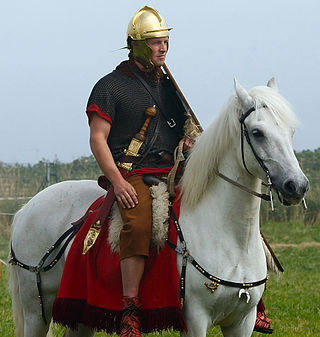
Roman cavalry refers to the horse-mounted forces of the Roman army throughout the regal, republican, and imperial eras.
The Early Roman army was deployed by ancient Rome during its Regal Era and into the early Republic around 300 BC, when the so-called "Polybian" or manipular legion was introduced.

The Roman army of the mid-Republic, also called the manipular Roman army or the Polybian army, refers to the armed forces deployed by the mid-Roman Republic, from the end of the Samnite Wars to the end of the Social War. The first phase of this army, in its manipular structure, is described in detail in the Histories of the ancient Greek historian Polybius, writing before 146 BC.

The Roman army of the late Republic refers to the armed forces deployed by the late Roman Republic, from the beginning of the first century BC until the establishment of the Imperial Roman army by Augustus in 30 BC.


